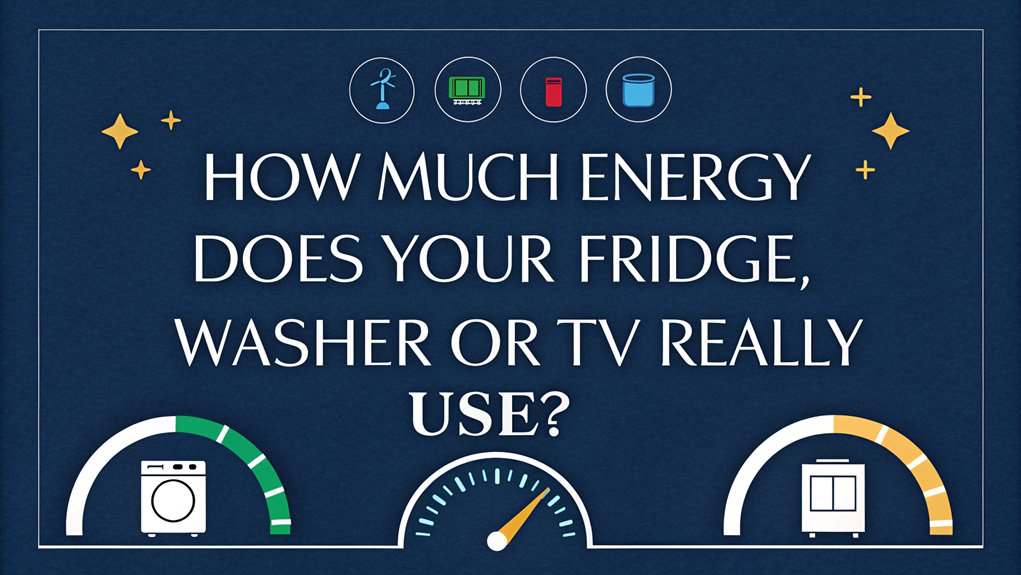Your fridge typically uses about 657 kWh annually, costing roughly $78.84. ENERGY STAR models are more efficient, at around 28 kWh monthly. Modern washers consume approximately 255 watts per hour, depending on usage frequency and settings, while air-drying clothes saves energy. Televisions, especially HDTVs over 40 inches, average 341 kWh yearly, costing $41. Adjusting settings and maintaining your appliances optimizes efficiency and lowers bills. Discover more insights to enhance your energy management.
Key Facts Summarized
- Average refrigerators consume around 657 kWh annually, costing approximately $78.84.
- Modern washing machines use roughly 255 watts per hour, costing about $9.55 annually for eight weekly loads.
- Large HDTVs over 40 inches consume approximately 341 kWh annually, costing around $41.
- ENERGY STAR refrigerators use about 28 kWh monthly, costing roughly $4.23 annually.
- Cold wash settings and air drying clothes significantly reduce washing machine energy consumption.
Understanding Energy Consumption in Household Appliances
When it comes to understanding energy consumption in household appliances, it’s crucial to recognize how each device contributes to your electricity bill.
Your refrigerator/freezer combo uses about 657 kWh annually, accounting for 7% of your home’s total energy use. This translates to approximately $78.84 per year.
Washing machines, although not as energy-hungry, still impact your average electricity costs. Operating at 255 watts per hour, they cost around $9.55 annually when used six hours weekly.
By choosing energy-efficient appliances, like ENERGY STAR certified models, you can greatly reduce these expenses. For instance, replacing standard models with efficient ones guarantees long-term savings. Regular meter monitoring helps you track energy consumption and identify any unexpected changes in usage.
Understanding these details helps you manage and optimize your appliances’ use, ultimately lowering your electricity bill.
The Impact of Refrigerators on Energy Bills
Understanding how specific appliances impact energy consumption is essential to managing your electricity costs effectively. Refrigerators are responsible for about 7% of your home’s total energy usage, greatly affecting your bills.
The average refrigerator uses around 657 kWh annually, costing about $78.84. Opting for ENERGY STAR® certified refrigerators, which are more energy-efficient, can reduce this cost. These models only consume about 28 kWh per month, translating to roughly $4.23.
Older refrigerators often use more energy, increasing your operational costs. To enhance efficiency and potentially lower expenses, regular maintenance is vital.
Make sure to clean the condenser coils periodically. This simple practice can prevent your refrigerator from overworking, maintaining its efficiency and keeping your electricity costs in check. Additionally, conducting home energy audits can help identify high-energy devices and prioritize unplugging efforts.
Exploring Energy Efficiency in Modern Washers
Although energy consumption is a key concern for homeowners, modern washers offer a practical solution by remarkably reducing electricity usage.
Modern washing machines consume around 255 watts per hour, translating to an average annual electricity cost of approximately $9.55 if you do eight loads weekly.
Opting for an energy-efficient washing machine, particularly those with ENERGY STAR certification, can lower energy consumption considerably.
You can further cut electricity costs by using cold wash settings since heating water is a major energy draw.
Additionally, air drying your clothes instead of relying on the dryer can lead to substantial energy savings.
Furthermore, utilizing a whole-home energy monitor can help you identify additional energy-saving opportunities across all your appliances.
How Television Technology Affects Energy Use
Television technology plays a notable role in household energy consumption, especially for regular viewers.
HDTVs over 40 inches consume about 341 kWh per year, costing approximately $41.00 annually. In contrast, LCD televisions typically run at around 150 watts, potentially reducing energy costs to under $27 per year.
The power consumption of a 40-inch HDTV averages 234 watts per hour, which greatly impacts overall electricity use. Considering the average American watches four hours of TV daily, your cumulative energy use can be substantial.
To manage costs, consider upgrading to more energy-efficient models and reducing viewing time. Additionally, shifting to LED lighting in your home entertainment setup can further enhance energy efficiency by cutting down on lighting costs.
Factors Influencing Energy Use in Refrigerators
When evaluating the energy use of refrigerators, it’s essential to take into account several influencing factors.
Energy consumption in refrigerators can vary greatly based on size, efficiency, and maintenance practices. On average, refrigerators use approximately 657 kWh annually, costing about $78.84.
However, ENERGY STAR certified models, like a 14 cu. ft. unit, consume just 28 kWh per month, reducing energy costs to about $4.23. Larger models, such as 25 cu. ft. bottom freezers, can use up to 59 kWh monthly, costing roughly $8.91.
Regular maintenance, including cleaning condenser coils and ensuring proper airflow, is vital for optimizing energy efficiency.
Tips for Reducing Washer and Dryer Energy Costs
To cut down on the energy costs associated with washing machines and dryers, focus on a few practical strategies.
- Use cold settings on your washing machine. Heating water spikes energy consumption, so cold washes can greatly reduce your energy use.
- Air-dry clothes whenever possible. Dryers can consume up to 2,790 watts per hour, inflating your annual energy costs.
- Wash full loads to maximize energy efficiency. This practice minimizes the number of cycles, saving you over $9.55 annually on energy consumption.
- Invest in high-efficiency appliances. Energy-efficient washing machines and dryers reduce electricity usage per load, helping to further lower your annual energy costs.
Comparing Energy Use Across Different TV Models
While choosing a TV, understanding its energy consumption can help you manage electricity costs effectively.
A 22-inch LED TV uses about 17 watts, whereas a 32-inch LED model ranges from 20 to 60 watts, depending on settings. Comparatively, a 40-inch HD TV has an average energy consumption of 234 watts per hour, leading to an annual cost of approximately $41, based on average electricity rates.
Switching to an energy-efficient LCD TV can lower this to under $27 annually. Given that the average American watches four hours daily, this results in substantial cumulative energy use. By utilizing smart plugs, you can further optimize energy savings by cutting off standby power and scheduling usage during off-peak hours.
For energy-conscious consumers, knowing each model’s wattage and annual cost is essential to managing electricity expenses and choosing the most energy-efficient option.
The Role of Regular Maintenance in Appliance Efficiency
Having chosen an energy-efficient TV model, let’s explore how regular maintenance can guarantee your appliances run at their peak efficiency, minimizing energy costs.
An effective maintenance routine reduces energy usage and keeps utility bills in check. Here’s how you can maintain various appliances:
- Refrigerators: Clean the condenser coils regularly to prevent increased energy usage and enhance overall efficiency.
- Dishwashers: Make sure they’re well-maintained to reduce energy consumption compared to older or poorly maintained models.
- Washing Machines: Use cold water settings and avoid overloading to greatly decrease energy use with each cycle.
- Air Conditioners: Conduct routine checks and servicing, potentially saving around $460 annually by improving efficiency.
Regular maintenance identifies potential issues early, preventing spikes in energy consumption and reducing utility bills. Additionally, by implementing circuit-level monitoring, homeowners can gain insights into specific appliance usage, further enhancing their energy-saving efforts.
Real-Time Energy Monitoring for Better Savings
When it comes to cutting down on energy costs, real-time energy monitoring stands out as an invaluable tool for homeowners. By tracking energy consumption at a device level, you can identify which appliances, like your fridge or TV, are energy hogs.
Tools like the Wiser Energy home monitor provide real-time data, helping you optimize appliance usage, especially during off-peak hours. This approach not only maximizes energy savings but also reduces costs associated with time-of-use electricity rates.
Smart home integration, such as with Schneider Home, takes it a step further by automating energy schedules based on real-time data. This guarantees appliances run efficiently, minimizing electricity bills. Additionally, smart meters enable two-way communication, allowing consumers to monitor their usage through mobile apps, minimizing power wastage and alerting them to energy consumption.
Additionally, early detection of issues can prevent inefficient appliances from driving up energy consumption, supporting long-term savings.
Making Informed Decisions With Energy Data
Although energy consumption data can seem overwhelming, leveraging it effectively empowers you to make smarter decisions about your appliances. By understanding electricity usage and annual costs, you can enhance energy efficiency, cut down on your energy bill, and reduce household energy consumption.
Consider these practical steps:
- Evaluate Usage: A typical fridge uses 657 kWh annually, costing $78.84. Knowing this helps prioritize upgrades.
- Analyze Costs: TVs over 40 inches can cost $41.00 yearly, highlighting potential savings by adjusting usage patterns.
- Opt for ENERGY STAR: ENERGY STAR appliances offer long-term savings by minimizing energy usage.
- Maintain Regularly: Routine maintenance and ideal settings are crucial in enhancing efficiency for appliances like washers and refrigerators.
- Monitor Consumption: Using an amperemeter can provide real-time insights into the energy draw of your appliances, helping you identify inefficiencies.
Use this data to make informed energy decisions.
Frequently Asked Questions
Does a TV Use More Electricity Than a Fridge?
A TV doesn’t use more electricity than a fridge.
A typical fridge runs continuously, consuming around 657 kWh annually, while a 40-inch TV, used about four hours daily, uses approximately 341 kWh per year.
This means your fridge accounts for a larger chunk of your electricity bill.
To manage costs, make sure your fridge’s seals are tight and consider energy-efficient models for both appliances.
Adjust usage patterns for further savings.
What Wastes the Most Electricity in a House?
Oh, the villainous air conditioner, lurking as your home’s top electricity guzzler.
It’s like a summer blockbuster’s nemesis, consuming around 3,500 watts hourly.
But fret not! You can outsmart it by optimizing usage and embracing fans or programmable thermostats.
Don’t overlook those inefficient incandescent bulbs either; swap them for LEDs to save energy.
What Runs Your Electric Bill up the Most?
Your electric bill climbs primarily from high-consumption items like air conditioning and refrigerators.
The AC unit alone can drain up to 3500 watts per hour, costing about $460 annually. Refrigerators consume around 657 kWh each year, adding another $78.84.
To manage costs, consider upgrading to ENERGY STAR appliances, which use less energy.
Also, be mindful of usage patterns, like reducing AC hours and unplugging electronics when not in use.
What Appliances Use the Least Electricity?
It’s interesting how the smallest appliances often use the least electricity.
Your ENERGY STAR fridge, especially the 14 cu. ft. one, only sips 28 kWh monthly, costing around $4.23.
When you wash clothes in cold water, your washer’s energy use drops notably, costing roughly $9.55 annually.
Plus, your modern LED TV uses less than $27 worth of energy yearly.
Efficient choices like these can lead to surprising savings on your bill.
Conclusion
Imagine your home as a living, breathing entity, where every appliance hums its own energy tune. By understanding the nuances of energy consumption—from the silent hum of the fridge to the vibrant glow of your TV—you can orchestrate a symphony of savings. Embrace energy-efficient models, maintain them regularly, and monitor usage in real-time. With data as your guide, you’ll make informed decisions, turning your household into an efficient, cost-effective masterpiece.

